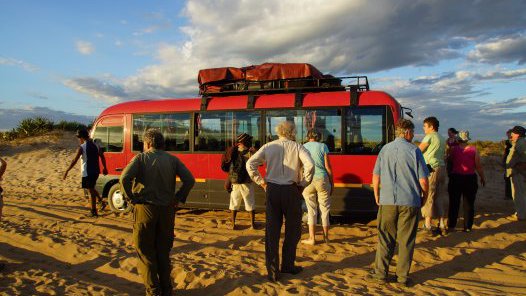Reflections on Madagascar
Written by Amanda Berry, Australian Museum Member
Long before David Attenborough whispered words like ‘extraordinary’, ‘bizarre’ and ‘unique’, I have been curious about the wildlife of Madagascar. Not being a particularly brave traveller but still wanting to get out and about, I adhere to the adage ‘safety in numbers’. A tour seemed a sensible way to travel, especially if those companions also happened to be like-minded, well-educated fellow Australians. So my husband and I, together with fourteen other Australian Museum Members, travelled to Madagascar in May 2012.

© Amanda Berry
From Sydney our tour was entertainingly escorted by Tour Assistant, Robert. Our first overnight stop was St Denis on La Reunion Island, a delightful French outpost on a volcano in the middle of the Indian Ocean, twelve hours flight from home.
Air Austral delivered us to Madagascar’s capital the next day. There we met our fun Malagasy guide, Lytah, an impressively trilingual young man, passionate about his country and its wildlife. Lytah was capable of perfect mimicry of every bird we saw and was able to find chameleons in the vegetation… from inside a moving bus.

© Amanda Berry
Our cheerful driver, Andre, increased his considerable fitness daily by lifting our luggage on and off the roof of the bus. He drove us calmly through sometimes chaotic traffic, the tightest of parking spaces and bus-stopping sand. We were also privileged to be accompanied by Dr Steven Goodman, the encyclopaedic yet easygoing, American conservation biologist. Steve has lived in Madagascar for more than twenty years (when he isn’t in Chicago or travelling to Europe to collect another International Scientific accolade). So, the collective wisdom and knowledge about Madagascar available to us was everything we could possibly have wanted and more.
The tour was called ‘Madagascar – A World Apart’ and it was obvious that we had indeed arrived in a very different place. In Antananarivo, zebu carts shared the road with ancient, overloaded vehicles. The streets teemed with people pushing wooden trolleys or carrying heavy loads on their heads. We passed a rubbish dump where there had been an outbreak of Bubonic plague and headed into the city where on-going volatile, political instability and desperate poverty are the norm. I did wonder what I had signed up for. However, we drove straight through the rice-paddy fringed capital and were soon enchanted by the ‘party-whistle’ call of the Indri (lemur) and the magic of the forest at Andasibe.
Most of our well-travelled group, who conversationally mentioned things like ‘When I was kayaking in Antarctica …’, were quietly standing in the forest astonished to see lemurs, insects, reptiles, birds and plants that no-one (except George who had been to Madagascar many times) had ever seen before. However, the lemurs are endangered and their forest habitats are diminishing under increasing pressure from a growing human population, despite National Park boundaries and laws intended to protect them.
Madagascar is like a giant quilt with unique patches of biologically diverse landscape, soil, climate, vegetation and wildlife. The plants and trees are not colonisers, so when the land is cleared for slash and burn agriculture or firewood, that area will not regrow and is lost. As the sign told us at the Red Tsingy in the north: ‘It is not no-where else’ which is true for each biome on the island.
On some days, it felt like we were observing life from centuries ago, especially during our visit to the silk-weaving village of Soatanana. No glass, steel, running water or electricity in their mud-brick and wooden houses. The Malagasy are incredibly hard-working, inventive and skilled, but only approximately forty percent are literate. They do understand and are worried by the land-use problems in their country, but they are traditional in their practises. The situation is unlikely to change any time soon. As we travelled around the island we gained considerable insight into the fascinating culture and beliefs of the eighteen different tribes of Malagasy people… an evolving blend of influences and heritage.
We travelled from Antananarivo in the centre of Madagascar south along Route Nationale 7 to incredibly dry Toliara on the south-west coast, taking two weeks. After a short Air Madagascar flight to Fort Dauphin in the south-east, we drove to visit Berenty Private Reserve – a four hour, but only ninety kilometre, bone-jarring drive through spectacular landscape. The vegetation changed from rice-growing and lush rainforest near the coast to remarkable Spiny forest further inland, much of which has been cleared for sisal plantations. Flying via Antananarivo, we explored the north from our base in Diego Suarez, a town of faded French colonial glory. From there, we experienced two more completely different patches of the quilt. At Montagne d’Ambre Parc Nationale we walked in montane rainforest, delighted by the wealth of chameleons and geckos found by our local guides. The next day, we visited Ankarana Parc Nationale and saw the unforgettable Grey Tsingy… super-spiky limestone that was, quite some time ago, at the bottom of the sea.
So, having seen so much of Madagascar, yet been cushioned from the harsh reality of life as a Malagasy, I offer these words to describe my experience: ‘majestic’ – the Tsaranoro Valley is a spectacular place, ‘ephemeral’ – much of what is precious is hanging by a thread and ‘beguiling’. In one way or another, Madagascar had charmed and delighted us all. Sir David can use these words for his next documentary, if he likes.





































